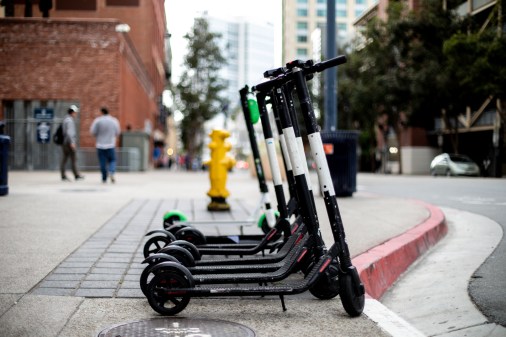How smartphones improved real-time bus tracking in D.C.

Editor’s Note: This story was updated January 13 to reflect new information from Eastbanc Technologies.
The ability to track the location and movement of Washington, D.C.’s buses in real time is about to get more precise — and less expensive — thanks to smartphone technology.
The new system replaces an older, slower more costly system, which made real-time monitoring and management cumbersome. It relies on smartphones installed on each bus, transmits location data continuously and makes it easier to relay that information, via existing application programming interfaces, in real time to riders using consumer-facing mobile apps.
By the end of February, 64 D.C. Circulator buses will be equipped with smartphones that will send the vehicle’s location every three seconds to a central data hub housed at D.C.’s Department of Transportation headquarters, according to José Colón, the DDOT chief information officer. The Circulator buses serve riders in Washington and are part of a larger fleet of buses serving the greater metropolitan area.
Using software developed by D.C.-based EastBanc Technologies that works on all of the leading smartphone platforms and mobile carrier networks, the smartphone system allows DDOT officials to track the location of buses more reliably than the current built-in technology used on buses, Colón said.
DDOT initially tasked the company with developing a data-driven way to track the location of buses more efficiently and reduce the tendency of buses to bunch up in traffic, according to Andrew Norris, director of sales operations at EastBanc Technologies.
But after reviewing DDOT’s data, Norris and his team realized that the data-capturing system DDOT was using failed to capture data quickly enough and that the information was incomplete. The “little gray plastic boxes” on the buses that track the vehicle’s location sometimes only worked on 60 percent of the fleet, and, even then, pinged the bus’ location at less precise intervals, Norris discovered.
Three minutes may seem like a decent interval, he said, until an accident or presidential motorcade interrupts a scheduled bus route.
“If a bus is driving along and an indication is sent out that it is on time and an accident happens in front of it and then it’s stopped there, that information doesn’t get relayed for another three minutes,” Norris told StateScoop. “If I’m standing there expecting my bus to be here in two-and-a-half minutes, I’m now five minutes plus off, then [the bus system has] lost all of the trust of the customer.”
In response, EastBanc proposed an alternate approach, involving common smartphone technology that takes advantage of the multiple sensors that come standard on most devices. Compared to the old gray-box method, utilizing smartphones for bus tracking is cheap, reliable and easily accessible.
“What is a smartphone in reality?” Norris said. “It’s a bundled cluster of sensors for geographical location, acceleration, deceleration and gimbal, or the movement of the bus.”
DDOT and EastBanc ran a pilot test of 15 devices on buses in October. The results were impressive enough that the agency is installing the devices across its total fleet of 64 Circulator buses in the coming weeks.
“Those smartphones are reporting accurately, and we’re really impressed with that,” Colón said. “And they’re cheap, too. I think we feel very comfortable now [with the technology].”
For Colón, the new system also promises to support the department’s transparency efforts by being able to “push that data back out to the public.”
In addition to delivering information through consumer-facing mobile applications, Colón said the data will also be ported directly to DDOT’s RideDC platform — a tool, currently in beta, for businesses and individuals to use to create their own transit mode dashboard. The RideDC application also features data on the Washington Metropolitan Area Transit Authority’s Metrobus and Metrorail, Car2Go, and DDOT’s Capital Bikeshare.
In addition to the Circulators, the devices will also be used to track D.C.’s soon-to-be-deployed streetcars. According to Colón, three devices are in place on streetcars the city is testing.
The costs to the District are relatively low, Colón said. Due to already established contracts with technology vendors, the department receives the devices at a very low cost, or, in some cases, for no cost at all. Plus, due to the cross-platform efficiency, the tracking software works on several different platforms.
The services EastBanc provided DDOT are billed and established as a software-as-a-service platform. According to Peter Shashkin, a software development manager at EastBanc, the total cost to DDOT was $95,000.
“The device reporting Internet of Things system is just part of it,” Shashkin said. “We also have a mobile application for them as part of the deal, and some trip planning screens and displays for bus stops.”
Right now, there are no plans in place to roll out the updated tracking technology to the Metrobus system operated by the Washington Metropolitan Area Transit Authority; however, according to Shashkin and Norris, EastBanc has previously pitched the service to the mass transit organization.
“We had some presentations for WMATA,” Shashkin said. “They did express interest, but we weren’t able to push it as far as we did for the Circulator.”
But not having an initial rollout across WMATA’s fleet of thousands of buses might not be the worst thing, Shashkin said. Instead, EastBanc can prove the applicability of the technology on a smaller scale through the Circulator initiative. If it’s successful, WMATA may consider adopting the technology.
Washington, D.C., isn’t the only location that EastBanc is working on this type of real-time, IoT-enabled tracking, either. The company is working with Miami-Dade County in Florida on a pilot and has developed a back-end tracking platform in Houston.




